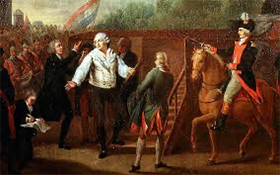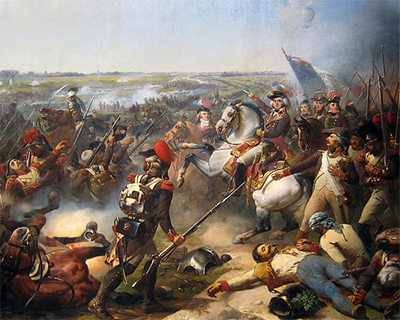The War of the First Coalition
Part 3: A Grand Coalition Back in Paris, the National Convention had been overrun by republican fervor, such that many were blaming the king for the early defeats and absolving him of any credit for the recent victories. More ominously, the Convention called the king to trial, on Dec. 11, 1792. He had been arrested after the August storming of the Tuileries and kept in the Temple. When the government abolished the monarchy, he became known as Citoyen Louis Capet. The main charge was treason, stemming from his attempt to flee the country in June 1791. The Convention also charged the king with attempting to ally with France's enemies in order to engineer an overthrow of the government and reinstate himself as the supreme head of the state. The discovery of an iron chest containing compromising correspondence validated this charge. 
Many republicans in the Convention wanted the end of the monarchy in any form and many who wanted the king dead. Foremost among these was Maximilien Robespierre, who declared that, "Louis must die so the nation may live." After a series of spirited debates, the Convention voted to convict the king. That vote was unanimous. The debate then turned to how to punish the king. That ended in a vote as well, and many deputies voted against execution. However, a majority did, and so the king indeed was put to death, on Jan. 21, 1793. He was 38. Among his last words were these: "I die innocent of all the crimes laid to my charge; I Pardon those who have occasioned my death; and I pray to God that the blood you are going to shed may never be visited on France." As many moderates had warned, the execution of the king united the rest of Europe in opposition to the Republic. The First Coalition came about when France declared war on Great Britain, the Netherlands, and Spain and then the Holy Roman Empire, Naples, Portugal, and Tuscany declared war on France. To fight this new consortium, the National Convention introduced a large conscription, swelling the French ranks even more. Out in the field, Dumouriez persevered with his cherished invasion of the Netherlands, gaining a few footholds but losing more of what he had so recently achieved. A resurgent Austria won at Aachen and Liège and then Neerwinden, forcing a French retreat straight out of Belgium. The resulting peace agreement was of more of a personal nature, as Dumouriez offered to restore the monarchy in Paris; when his troops refused to follow his orders, he crossed over and joined the Austrian army. Added to that trouble in the northeast was trouble in the south, as revolts broke out in Lyon and Marseilles and the ongoing insurrection in the Vendée flamed white hot, fueled by talks of an alliance with Great Britain. France faced a severe fear of encirclement when Spanish armies vaulted the Pyrenees, Sardinian armies appeared out of the Alps, and Britain instituted a naval blockade. Symptomatic of the stretched nature of French defenses at this point, despite the large conscription, was the loss of Toulon, to Britain and Spain, in August. (A young Napoleon Bonaparte would help Gen. Jacques François Dugommier retake the city in December.) French armies rebounded later in the year, under Nicolas Houchard forcing Britain to abandon a siege of Dunkirk in September and, under Jean-Baptiste Jourdan, defeating a Dutch-Hapsburg coalition force at Wattignies in October. 
Jourdan continued his success in 1794, winning the Battle of Fleurus in June. This victory was significant for a number of reasons, including that it was the first use of a reconnaissance balloon in warfare, by France. The target was the fortress of Charleroi, in the Lowlands. Jourdan had been given even more men to achieve this task, and the French army beat back a counterattack on the way to successfully besieging the fortress, seizing it on June 25. An Austrian army attacked the French army in the field the following day. After initial success on the edges, the Austrian attackers gave way to a fierce French counterattack, which rolled up the Austrians and forced a retreat over the Rhine River. This gave France complete control of the Lowlands. Jourdan gave full credit to the information that was relayed from the balloon, which hovered undisturbed throughout the battle. Word of the French victory made its way to Paris and lent credence to those who were questioning the need for the draconian measures laid down by the Committee of Public Safety during the Reign of Terror. Indeed, Louis de Saint-Just, one of the leaders of the crackdown, returned from his role as an observer at Fleurus and announced that victory and a few others, trumpeting the glory of the republican army's successes. A mere month later, he was ousted from his preeminent position and on his way to the guillotine, along with the architect of the Reign of Terror, Maximilien Robespierre. Meanwhile, French armies advanced on all fronts, driving Prussian armies back and out of the war and Spanish armies deeper into their own territory. By the end of 1794, France was ascendant. Next page > French Victory > Page 1, 2, 3, 4 |
|
Social Studies for Kids
copyright 2002–2025
David White




